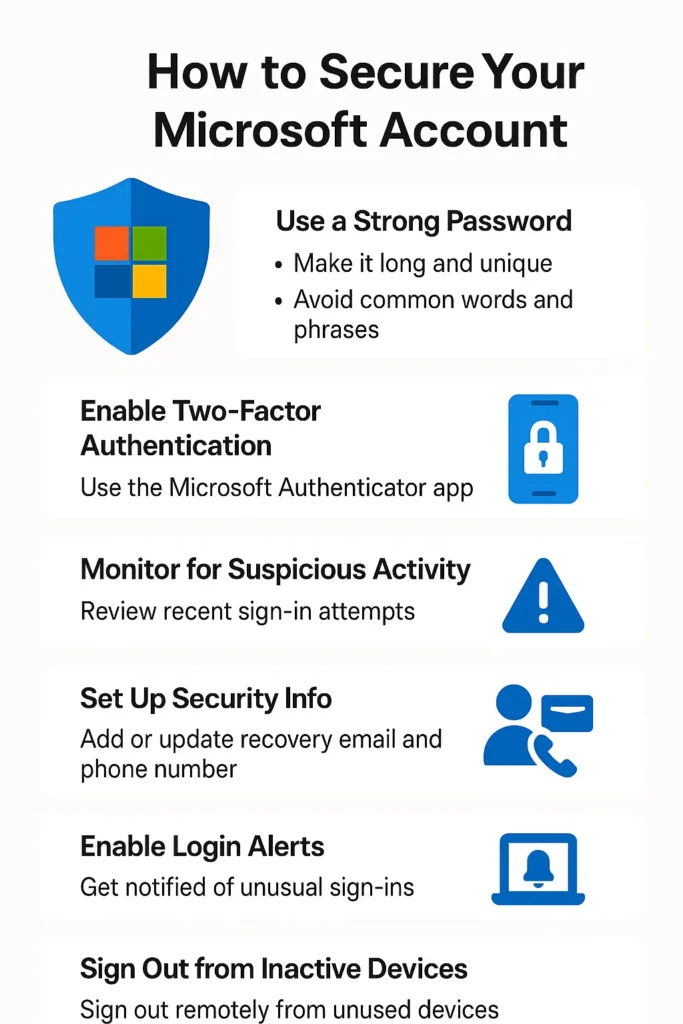Secure a Microsoft Account : In an age of growing cyber threats, securing your Microsoft account is more important than ever. Whether you use your account for Outlook, OneDrive, Teams, Xbox, or Microsoft 365, protecting your login credentials and personal information is crucial. This guide will walk you through proven steps to safeguard your Microsoft account from hackers and unauthorized access.
Why Securing Your Microsoft Account Matters
Your Microsoft account holds sensitive data, including:
- Emails and contacts (Outlook)
- Documents and files (OneDrive)
- Financial info (Microsoft Store)
- Communication records (Teams & Skype)
- Gaming and subscriptions (Xbox Live)
A breach can compromise your entire digital identity. Let’s explore the best practices to secure your Microsoft account.
Step 1 – Use a Strong and Unique Password
Best Practices for Strong Passwords
- Use a mix of uppercase, lowercase, numbers, and symbols.
- Avoid using personal details (name, birthday, etc.).
- Password should be at least 12 characters long.
- Use a password manager to generate and store secure passwords.
How to Change Microsoft Account Password
- Visit account.microsoft.com.
- Sign in to your Microsoft account.
- Click Security > Password security.
- Verify your identity.
- Enter your current password and create a new one.
- Click Save.
Step 2 – Enable Two-Factor Authentication (2FA)
Two-step verification adds a second layer of protection beyond your password.
How to Enable 2FA on Microsoft Account
- Go to Microsoft Security Settings.
- Click on Advanced security options.
- Under Two-step verification, click Turn on.
- Choose your verification method (phone, email, or Microsoft Authenticator app).
- Follow the on-screen steps to complete the setup.
✅ Pro Tip: Use the aka.ms/authapp for faster and more secure sign-ins.
Step 3 – Monitor for Suspicious Activity
Early detection of unusual activity can help prevent full account breaches.
How to Check Microsoft Account Activity
- Visit the Recent Activity page.
- Sign in to your account.
- Review recent logins, device types, and locations.
- If you notice suspicious access:
- Click “This wasn’t me”.
- Change your password immediately.
Step 4 – Set Up Security Information Recovery Options
Always keep your recovery email and phone number updated.
Update Recovery Info
- Go to Microsoft Account > Security.
- Under Update your security info, click Edit info.
- Add or update your email and phone number.
- Verify your recovery options.
Step 5 – Enable Login Alerts and Set Trusted Devices
Turn on Login Notifications
- Microsoft sends alerts when your account is accessed from a new location or device.
- Keep these notifications enabled in your security settings.
Mark Trusted Devices
- When prompted, select “Don’t ask again on this device” to mark trusted devices.
- Never mark public/shared devices as trusted.
Step 6 – Sign Out of Devices You’re Not Using
Manage active sessions to ensure you’re not logged in on unknown devices.
How to Sign Out Remotely
- Go to Microsoft Devices.
- Review the list of devices.
- Click “Remove device” or “Sign out” as needed.
Step 7 – Stay Updated and Use Antivirus Protection
- Regularly update your OS and apps to patch vulnerabilities.
- Use Microsoft Defender or a trusted antivirus software.
- Avoid clicking suspicious emails or downloading unknown files.
Additional Tips to Secure Your Microsoft Account
- Enable biometric login like Windows Hello for extra protection.
- Avoid using your Microsoft account on public Wi-Fi without a VPN.
- Don’t share your account credentials with anyone.
- Check connected apps and revoke access to apps you no longer use.
Conclusion
Your Microsoft account is the gateway to your personal and professional life. Taking a few simple but effective steps — such as setting up a strong password, enabling two-factor authentication, and monitoring account activity — can significantly reduce the risk of unauthorized access.
Don’t wait for a security breach to take action. Secure your Microsoft account today and stay protected in 2025 and beyond.
Common Questions About Microsoft Account Security (FAQs)
Is 2FA enough to protect my Microsoft account?
2FA is a strong layer of protection, but you should combine it with strong passwords and device management.
Can I recover my Microsoft account if it gets hacked?
Yes, by using your security recovery options or visiting Microsoft Account Recovery.
What is Microsoft Authenticator?
It’s a mobile app that allows secure sign-ins using a verification code or push notification.
